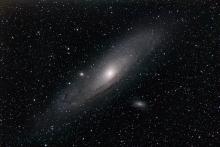This infrared view, captured by Spitzer Space Telescope, clearly outlines the spiral arms of Messier 31, the Andromeda Galaxy. The arms are filled with infrared-emitting gas and dust that give birth to new stars. Many newborn stars in the arms are bright and massive, so they help outline a galaxy's spiral arms. [NASA/JPL-Caltech/K. Gordon (University of Arizona)]
You are here
Spiral Arms
The two most prominent spiral galaxies in the night sky are in good view tonight — especially after the Moon sets in late evening. The Milky Way Galaxy arcs high across the sky, from teapot-shaped Sagittarius low in the south, to the Northern Cross high overhead, to W-shaped Cassiopeia in the northeast. And M31, the Andromeda Galaxy, is to the lower right of Cassiopeia. It looks like a tiny cloud. You need clear, dark skies to see Andromeda or the Milky Way.
A spiral galaxy consists of a wide, flat disk with a big bulge of stars in the middle. Its most beautiful features, though, are its spiral arms — bright ribbons that wrap around the galaxy’s heart.
The arms are outlined by young stars that are especially hot and bright. There are just as many stars between the arms, but they’re generally older and fainter.
Astronomers are still pondering what causes spiral arms. The leading theory says that a wave travels around the galaxy like an ocean wave rippling across the water.
There are several variations on how that creates the visible arms. One says the wave piles up clouds of gas and dust. The clouds are squeezed together, causing them to collapse and give birth to new stars.
Our solar system is in the Orion-Cygnus Arm of the Milky Way. It’s not a complete arm — it doesn’t wrap all the way around the galaxy. But it does contain some of the brightest stars in the night sky — stars that help outline our own spiral arm.
Script by Damond Benningfield
Get Premium Audio
Listen to today's episode of StarDate on the web the same day it airs in high-quality streaming audio without any extra ads or announcements. Choose a $8 one-month pass, or listen every day for a year for just $30.






